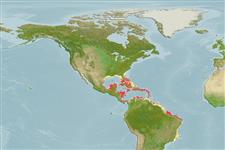Common names from other countries
>
Eupercaria/misc (Various families in series Eupercaria) >
Sciaenidae (Drums or croakers)
Etymology: Equetus: Latin, eques, -itis = horse, man in a horse, chevalier .
More on authors: Bloch & Schneider.
Environment: milieu / climate zone / depth range / distribution range
بوم شناسي
دريايي وابسته به آب سنگ; تغييرات عمق 3 - 30 m (Ref. 9710). Tropical; 36°N - 24°S, 98°W - 28°W
Western Atlantic: Bermuda, Florida (USA), and Bahamas to the Antilles (Ref. 26340) and Yucatan (Mexico) (Ref. 26938) to Brazil.
Size / Weight / سن
Maturity: Lm ? range ? - ? cm
Max length : 27.0 cm TL جنس نر / بدون خواص جنسي; (Ref. 26340); common length : 18.0 cm TL جنس نر / بدون خواص جنسي; (Ref. 5217)
خارهاي باله پشتي (کل) : 11 - 13; شعاع نرم باله پشتي (کل) : 45 - 47; خارهاي باله مخرجي: 2; شعاع نرم باله مخرجي: 6 - 8. First dorsal fin very high with short base. Second dorsal and caudal fins dark with white spots and dashes (Ref. 26938). Head white with two dark brown bars, one through eye, the other more posterior and more diagonal, extending across chest to pelvic fins; body white with a broad dark brown band beginning on front of first dorsal fin, curving across nape, above pectoral fin, and running to mid-base of caudal fin; two narrower dark stripes above and below this band (Ref. 13442). Mouth small, inferior, nearly horizontal. Spinous dorsal fin very elevated, higher than head length. Gas bladder simple, carrot-shaped without appendages. Sagitta (large earstone) near rounded and thick (Ref 51721).
Occurs primarily on coral reefs. Secretive and usually solitary, under ledges or near small caves (Ref. 7251). Often seen during the day around the bases of corals (Ref. 26938). Feeds at night on crabs, shrimps, and polychaetes. Easily approached (Ref. 9710). Has been reared in captivity (Ref. 35420).
Life cycle and mating behavior
Maturities | تولید مثل | Spawnings | Egg(s) | Fecundities | توزاد ( لارو)
Robins, C.R. and G.C. Ray, 1986. A field guide to Atlantic coast fishes of North America. Houghton Mifflin Company, Boston, U.S.A. 354 p. (Ref. 7251)
وضعيت در فهرست قرمز IUCN (Ref. 130435)
CITES (Ref. 128078)
Not Evaluated
خطر برای انسان ها
Reports of ciguatera poisoning (Ref. 30303)
استفاده انسانی
ماهي گيري – شيلات: ارزش تحاري اندك; آكواريوم: تجاري
ابزارها
گزارش های ويژه
بارگيری XML
منابع اينترنتي
Estimates based on models
Preferred temperature (Ref.
115969): 26.3 - 28.2, mean 27.4 (based on 675 cells).
Phylogenetic diversity index (Ref.
82804): PD
50 = 0.7500 [Uniqueness, from 0.5 = low to 2.0 = high].
Bayesian length-weight: a=0.00851 (0.00413 - 0.01752), b=3.08 (2.91 - 3.25), in cm Total Length, based on LWR estimates for this (Sub)family-body shape (Ref.
93245).
Trophic level (Ref.
69278): 3.5 ±0.3 se; based on diet studies.
جهندگی (Ref.
120179): زياد, كمينه زمان لازم براي دو برابر شدن جمعيت ، كمتر از 15 ماه (Preliminary K or Fecundity.).
Fishing Vulnerability (Ref.
59153): Low vulnerability (17 of 100).
